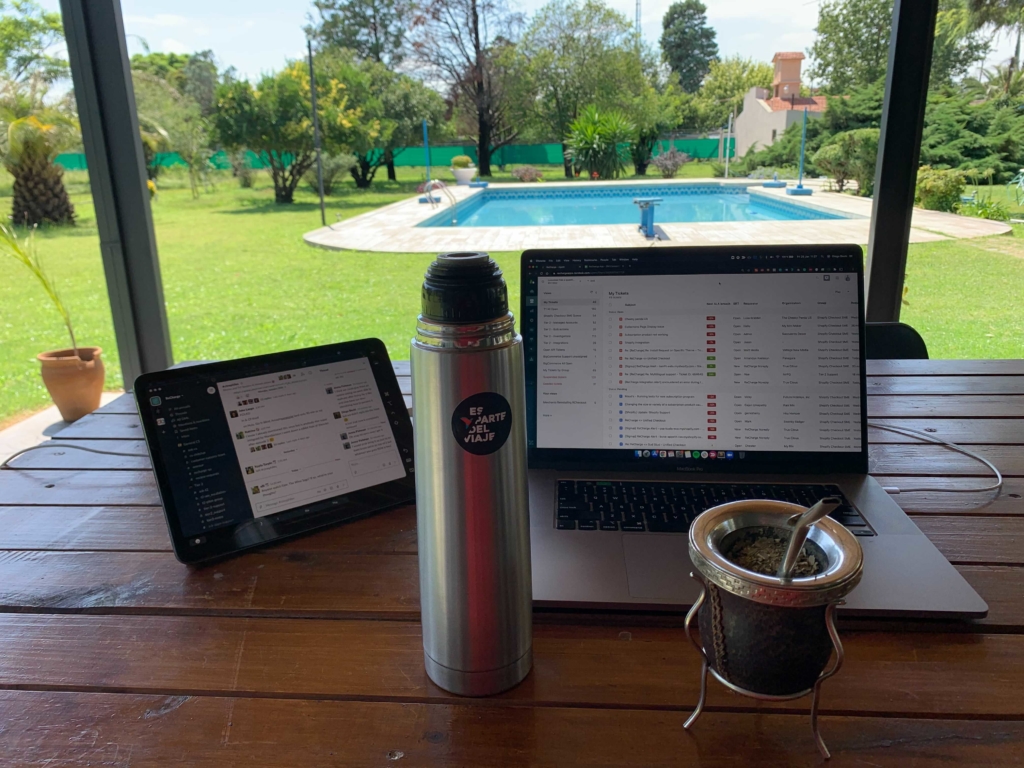Many merchants have been faced with a question over the this year: Do we create a remote or hybrid environment, or return fully to the office? While every company’s needs and requirements are different, the majority of the workforce is asking for at least the option to choose what’s best for them. According to a study done by PwC, over half of workers would prefer to work remotely at least 3 days a week.
Recharge was established as a remote-first company, and we wanted to share with you our favorite tools to help you in the event you decide to make the shift to remote work or hybrid remote work a final reality.
Keeping culture in mind
When considering offering remote work or a hybrid work space, you’ll need to make sure you have your bases covered with a variety of remote tools. We’ll share the specific tech stack we use but first, here are three of the most important tools you’ll need to have in place.
Communication is key
First you need a company wide communication tool. Something reliable and scalable that allows your team to instantly communicate with each other wherever they are in the world, as long as they have an internet connection. This tool needs to be intuitive, needs to be searchable and needs to be able to cut out the clutter. You likely have found one that works for you, even before the forced shift to remote work in 2020.
At Recharge, we use Slack. Slack allows us to easily direct message each other, have designated channels for specific teams, and quickly spin up channels or group messages. From a culture standpoint, Slack also allows employees to start specific channels where members can join around specific interests or hobbies. We have channels for sharing music, channels for sharing pictures of pets or channels for talking about the latest episode of the Bachelor.
Our most engaged channel is named “staying connected” where employees share pictures and videos from wherever they are in the world or ask open-ended get-to-know you questions (“What was your favourite Halloween costume?” or “If you could have any superpower what would it be?”) to engage with employees they may not interact with on a regular basis.

Connect with more than just text
The next tool that’s a necessity for companies looking to expand their remote work offerings: a video conferencing platform. If employees aren’t able to be in the same space as each other to collaborate and converse, having a tool where they can see each other face to face is the next best thing. At Recharge we use Zoom, while other businesses may use things like Google Hangouts or Skype.
Something else to consider when looking to implement remote or a hybrid work environment is what your video conferencing etiquette is. We recommend a camera-on policy for the majority of calls. It not only creates accountability in terms multitasking during meetings, but also gives everyone a chance to connect on more than just a text or voice level.
A fun tip: Encourage colleagues to include something in their backgrounds that can serve as a conversation piece. Whether it’s a picture on the wall, or something written on a white board, this is a great way for people to connect with each other around something other than the task at hand. It helps foster relationship building in an organic, meaningful way, and who knows… it might lead to friendships being forged over a common interest.
Other video meeting etiquette tips to consider: We encourage all colleagues to be presentable and be attentive. If they’re unable to prepare in terms of being camera-on, this is where we reserve the camera-off exceptions for.
Keep everyone in the loop
Staying organized and getting things done no matter the distance between your teammates is imperative to getting work done. The way to make it happen seamlessly? Your project management tool.
There are plenty of project management tools available to utilize, and at Recharge we use a variety between departments based on their needs and scalability. For our marketing team we use Monday.com whereas other teams use Jira (Atlassian). The most important thing is to find the tool that best works for you and allows you to set and achieve your goals. You need something trackable, that has an easy to navigate user experience and is going to scale with you as your team grows.
Some other types of tools you may need are:
- Internal Documentation
- Support Platform
- Organizational Chart
- Payroll and HR Tools
- Applicant Tracking System
Tips to creating a positive remote work environment
The best way to ensure a positive remote work experience is to embrace the change it instills and not try to conform it to traditional office working traits.
At Recharge we encourage our team members to work when they are most productive. We’ve got teammates working across the globe in dozens of different countries and numerous different time zones, so trying to regiment schedules to one timezones 9-5 clock just doesn’t work. Instead, what we care about is that you do good work, you get that work in on time and that you engage with your teammates and external groups effectively.
That freedom and trust resonates with Recharge team members who are able to work flexible schedules and set work around their life as opposed to life around their work. In our previously mentioned “staying connected” slack channel, a question was asked about what perks they loved most about the work from home lifestyle. There were dozens of responses, ranging from, “Being able drop and pick up my daughter from the bus stop every day” to “not wasting an hour each way commuting to work” to numerous responses from our travel addicts who are able to work from anywhere in the world they can find a reliable internet connection from.
The lesson here again is to honor remote or hybrid work for what it is and not try and conform it to the decades of traditional office work that preceded it. One of the most commonly asked questions about remote work is how do you trust your employees to be working when they’re supposed to be?

And the simple answer is: you trust them.
If they are not getting their work done or they aren’t attending meetings they should, then you have a problem. But remote work shouldn’t have some sort of employee surveillance attached to it to ensure team members are bolted to their desks for eight hours straight every day. If you don’t trust your employees to do the work they’re supposed to regardless of whether they’re working in the office or remotely—then you’ve got a bigger problem on your hands.
Some other things we do here at Recharge to ensure a positive experience for our employees, we encourage weekly 1:1s between managers and their direct reports. These meetings are a mix of formal (tracking projects, looking at KPIs, career planning) as well as informal (checking in on burn out, talking about life outside of work etc). For me personally, I feel more connected to my direct manager (whom after a year of working with, I’ve never met in person) than I have with any previous manager I’ve ever worked with.
Weekly department meetings are also encouraged to run through status reports on projects and to ensure alignment for the week ahead. We also host bi-weekly Town Halls where the entire company comes together for a meeting with senior leadership, and gets updates from various departments about various initiatives or the status of company-wide goals.
We’ve also had great engagement with an anonymous “Ask Me Anything” (AMA) that we host at the end of every Town Hall, where employees can freely ask any question to SLT or across departments that they may not feel comfortable saying publicly.
Embracing remote and hybrid work

Whether your company has made the jump to offering remote/hybrid work or you’re beginning to consider it, we hope this blog has walked you through some of the practical tips to ensure a smooth transition.
Remote work takes work. But done correctly, you can foster an environment of collaboration, team building, trust, accountability, and fun.



